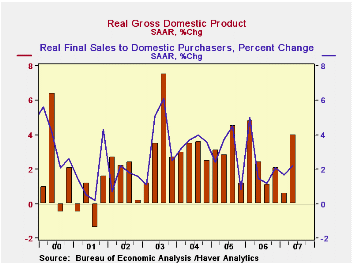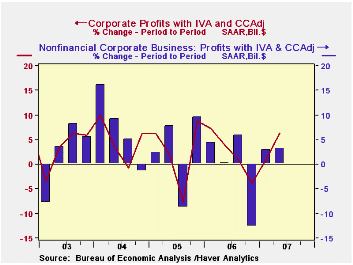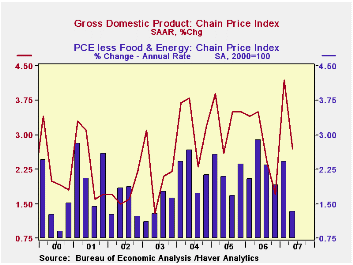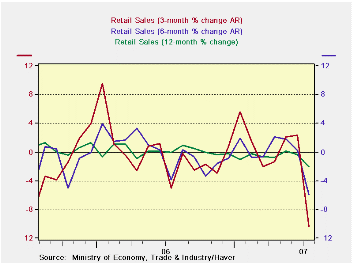 Global| Aug 30 2007
Global| Aug 30 2007US GDP Growth Revised Up, Profit Growth Slowed
Summary
U.S. real GDP growth during 2Q 2007 was revised higher to 4.0% (AR) from the advance report of 3.4% growth. The figure about matched consensus expectations for a 4.0 to 4.1% rise. Reported for the first time, 2Q profits (so-called [...]

U.S. real GDP growth during 2Q 2007 was revised higher to 4.0% (AR) from the advance report of 3.4% growth. The figure about matched consensus expectations for a 4.0 to 4.1% rise.
Reported for the first time, 2Q profits (so-called operating profits, with IVA and CCAdj) advanced 6.4%; weakness in the prior three quarters means the year/year growth was just 4.5%. Profits at U.S. nonfinancial corporations grew just 3.2% and they are below Q2 2006 by 1.4%. Financial companies saw good gains, 12.1% in the quarter, producing 5.4% from a year ago. Earnings from foreign operations posted a 5.4% increase, yielding 21.1% year/year.
Growth in final sales to domestic purchasers was revised to 2.2% from 1.7% initially reported.
Growth in business fixed investment was revised higher to an 11.1% (4.1% y/y) rate, from 8.1% reported last month. Spending both on structures and on equipment & software was enlarged, structures to 27.2% from 22.1% and equipment to 4.3% from just 2.3% in last month's tally.
Growth in real personal consumption expenditures was changed little at 1.4% versus 1.3%. Durables spending was cut to 0.4% growth from 1.6% last month, but nondurable goods showed only a 0.1% decline compared with 0.8% down reported before. Services were also reduced, to 0.6% growth from 2.2% showing earlier.
The decline in residential investment was deepened to 11.6% from 9.3%. The year/year change is now -16.4%, virtually the same size loss as in Q1.
Real consumption and investment spending by governments grew 4.1%, down marginally from 4.2% in the previous report.Inventories added 0.2 percentage points to GDP growth, the same as shown before, while the contribution of net exports was raised to 1.4 percentage points from 1.2 percentage points indicated before and a nice turnaround from Q1's 0.5 percentage point drag. Exports grew 7.6% and imports decreased 3.2%. 
The rise in the GDP chain price index was unrevised at 2.7%, in line with the average over the last year. The domestic final sales price deflator grew 3.8% (2.5% y/y). Consumer prices less food & energy rose just 1.3% (2.0% y/y), initially reported at 1.4%.
| Chained 2000$, % AR | 2Q '07 (Prelim.) | 2Q '07 (Advance) | 1Q '07 | Y/Y | 2006 | 2005 | 2004 |
|---|---|---|---|---|---|---|---|
| GDP | 4.0 | 3.4 | 0.6 | 1.9 | 2.9 | 3.1 | 3.6 |
| Inventory Effect | 0.2 | 0.2 | -0.7 | -0.4 | 0.1 | -0.2 | 0.4 |
| Final Sales | 3.7 | 3.2 | 1.3 | 2.4 | 2.8 | 3.3 | 3.3 |
| Foreign Trade Effect | 1.4 | 1.2 | -0.5 | 0.5 | -0.1 | -0.2 | -0.7 |
| Domestic Final Demand | 2.2 | 1.9 | 1.7 | 1.8 | 2.7 | 3.3 | 3.8 |
| Chained GDP Price Index | 2.7 | 2.7 | 4.2 | 2.8 | 2.6 | 1.7 | 2.1 |
by Robert Brusca August 30, 2007

In early 1990 and again in early 2002, Italy scored its highest readings on this index. But since 2002 confidence has dropped. As the Euro area picked up, Italy’s confidence also recovered but could barely get half-way back to its former peak at the end of 2006 and has since experienced back-sliding. The backsliding continues.
The confidence reading by consumers is only in the bottom third of its range of values since 1990. It has only been weaker in 1992-93, in the previous slowdown in late 2003-2004 and then in a short-lived bout of weakness in 1996. The weakening at this juncture is part of an established trend and so is more worrisome.
The overall situation over the next 12 months assesses out as in the bottom 8 percentile of is range. Unemployment appears more likely to respondents, in the top quarter of its range. Households put their past 12-month and future 12-month household financial situation in the bottom 25 percentile of its range. They say past savings were in the top 10% of their range but see savings prospects ahead in the bottom 10%. The purchase environment is in the bottom 40% of its range but ahead consumers expect it to be in the bottom 16 percentile.
Clearly, Italian consumers are not happy campers. They see many challenges and are having a harder time of it than other large Euro economies such as Germany and France. Italy, it seems, has lot of work to do. There is no longer a lira to depreciate when things get tough.
| Since January 1999 | ||||||||||
| Aug-07 | Jul-07 | Jun-07 | May-07 | Percentile | Rank | Max | Min | Range | Mean | |
| Consumer Confidence | 106.5 | 107.4 | 107.2 | 109.4 | 31.6 | 68 | 127 | 97 | 30 | 111 |
| Last 12 months | ||||||||||
| OVERALL SITUATION | -57 | -59 | -60 | -52 | 42.6 | 48 | -22 | -83 | 61 | -54 |
| PRICE TRENDS | -25 | -26 | -27.5 | -24.5 | 24.0 | 75 | 4 | -34 | 38 | -16 |
| Next 12months | ||||||||||
| OVERALL SITUATION | -29 | -25 | -22 | -18 | 8.6 | 93 | 24 | -34 | 58 | -12 |
| PRICE TRENDS | 22.5 | 18.5 | 19 | 17.5 | 36.9 | 46 | 49 | 7 | 42 | 23 |
| UNEMPLOYMENT | 0 | -3 | 2 | -5 | 76.9 | 21 | 9 | -30 | 39 | -6 |
| HOUSEHOLD BUDGET | 7 | 4 | -1 | 3 | 23.5 | 79 | 33 | -1 | 34 | 15 |
| HOUSEHOLD FIN SITUATION | ||||||||||
| Last 12 months | -37 | -34 | -40 | -35 | 25.0 | 65 | -7 | -47 | 40 | -28 |
| Next12 months | -10 | -10 | -9 | -10 | 25.0 | 96 | 14 | -18 | 32 | -1 |
| HOUSEHOLD SAVINGS | ||||||||||
| Current | 55 | 54 | 59 | 58 | 89.7 | 6 | 59 | 20 | 39 | 38 |
| Future | -35 | -34 | -33 | -28 | 10.3 | 97 | -9 | -38 | 29 | -23 |
| MAJOR Purchases | ||||||||||
| Current | -41 | -39 | -40 | -46 | 38.1 | 42 | -15 | -57 | 42 | -40 |
| Future | -68 | -68 | -63 | -71 | 16.1 | 74 | -42 | -73 | 31 | -62 |
| Total number of months: 100 | ||||||||||
by Robert Brusca August 30, 2007

Japan retail sales are mostly lower across the board.
Special factors have hit the Japanese consumer to be sure. There was a radiation leak at a nuclear plant that turned out to be worse that was first reported. And then a power shortage hit. Bad weather has interrupted the consumer. But through it all wages have remained stagnant and the consumer’s fundamentals have also failed to improve. So the sharp drop in consumer spending is not simply something to dismiss as due to some of these rogue factors that have haunted the consumer. The consumer may be feeling real pressure. In addition Japan is closely linked to the US economy and next month it will be interesting to see if Japanese moods and spending patterns are affected by the financial turbulence we have seen. With such weak spending it is hard to see why the BOJ would still be considering a rate hike.
| Jul-07 | Jun-07 | May-07 | 3-mo | 6-mo | 12-mo | Yr-Ago | |
| Total | -2.6% | -0.4% | 0.4% | -10.4% | -6.0% | -2.1% | 0.0% |
| Motor Vehicles | -0.4% | -2.5% | -0.1% | -11.3% | -6.9% | -4.8% | -11.1% |
| Food & Beverage | -0.8% | -1.2% | 0.1% | -7.3% | -2.5% | -0.7% | -0.4% |
| Fabric apparel & access | -8.2% | 0.4% | 0.0% | -27.7% | -11.8% | -10.0% | -8.6% |
| Rest of Retail | -3.4% | 0.4% | 0.7% | -9.0% | -6.9% | -1.1% | 4.5% |
Carol Stone, CBE
AuthorMore in Author Profile »Carol Stone, CBE came to Haver Analytics in 2003 following more than 35 years as a financial market economist at major Wall Street financial institutions, most especially Merrill Lynch and Nomura Securities. She had broad experience in analysis and forecasting of flow-of-funds accounts, the federal budget and Federal Reserve operations. At Nomura Securities, among other duties, she developed various indicator forecasting tools and edited a daily global publication produced in London and New York for readers in Tokyo. At Haver Analytics, Carol was a member of the Research Department, aiding database managers with research and documentation efforts, as well as posting commentary on select economic reports. In addition, she conducted Ways-of-the-World, a blog on economic issues for an Episcopal-Church-affiliated website, The Geranium Farm. During her career, Carol served as an officer of the Money Marketeers and the Downtown Economists Club. She had a PhD from NYU's Stern School of Business. She lived in Brooklyn, New York, and had a weekend home on Long Island.





